There’s just something extra special about a backdrop of bubbling lava, snapping tentacles, poisonous forests, sinkholes, cracking ice, an unbreathable atmosphere, or the approach of a blistering sunrise that amps up the excitement factor. The story was probably already pretty good, but now everyone might die on the way to wherever they’re going. And they might die horribly because someone thought it was a good idea to visit Paradise Not.
That someone could easily be me. I have a habit of putting my characters in horrible places and I’m going to place the blame on some of my favorite books and movies. We’ll start with Ursula K. Le Guin, who is known for testing every limit her characters have—and then some…
The Left Hand of Darkness by Ursula K. Le Guin
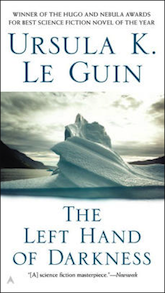 This is not the first book of Le Guin’s I ever read, but the one I remember the best. I find the themes of gender identity refreshingly challenging. But when I talk about The Left Hand of Darkness, I usually end up describing the part where Genly and Estraven spend eighty days traversing the northern Gobrin ice sheet. The environment is unspeakably harsh and Le Guin makes it enthralling. I could feel the fat melting away from Genly and Estraven as they balanced their daily calorie expense against necessary exertion. I shivered when I learned that it doesn’t snow when the temperature drops below a certain threshold. I didn’t ever want to know how cold that must be.
This is not the first book of Le Guin’s I ever read, but the one I remember the best. I find the themes of gender identity refreshingly challenging. But when I talk about The Left Hand of Darkness, I usually end up describing the part where Genly and Estraven spend eighty days traversing the northern Gobrin ice sheet. The environment is unspeakably harsh and Le Guin makes it enthralling. I could feel the fat melting away from Genly and Estraven as they balanced their daily calorie expense against necessary exertion. I shivered when I learned that it doesn’t snow when the temperature drops below a certain threshold. I didn’t ever want to know how cold that must be.
Not lost on me was the fact that the beyond bitter cold was the backdrop for the most important part of the book—Genly and Estraven learning to trust each other. It’s similar to putting two adversaries in a remote cabin with only one way in and one way out—and blocking that entrance with a grizzly. Makes a good argument for even a temporary truce, doesn’t it?
The Chronicles of Riddick
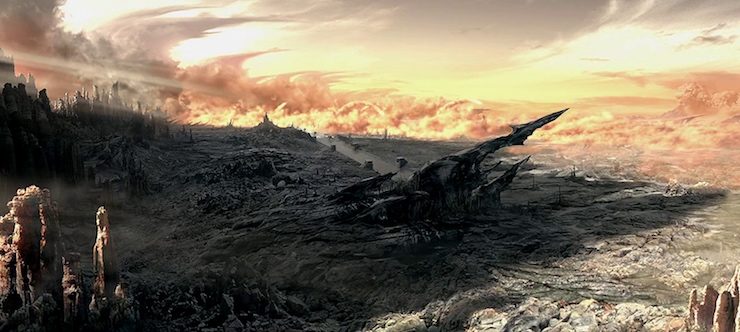
On the opposite end of the spectrum, we have Crematoria! I love this planet and not just because of the suggestion that about five hundred years in the future we’ll still be claiming the best real estate for prisons—in this case, a planet that will freeze your behind by night, only to roast it in the morning. If someone were able to escape the triple max prison buried deep beneath the surface of this abused planet, they’d probably die pretty quickly.
But not Richard Riddick. He and and an old friend plot their escape during the brief window between night and day. As if the terrain weren’t enough—smoking pits of… smoke, crumbling cliffs, falling ash—the sun is rising. The effect is awesome, like a spirograph of light on the far horizon. I won’t spoil the rest, except to note that the highlight of the movie, for me, is when half the party gets stuck by the advancing line of daylight and fiery plumes of lava.
2312 by Kim Stanley Robinson
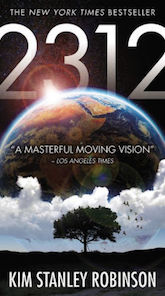 I love to hike and have aspirations of one day completing more than a single span of the Appalachian Trail. If we had an outpost on Mercury—either underground, or rolling across the surface in advance of the sun as depicted in Kim Stanley Robinson’s novel 2312—I’d probably want to hike there. The book begins with a tantalizing invitation:
I love to hike and have aspirations of one day completing more than a single span of the Appalachian Trail. If we had an outpost on Mercury—either underground, or rolling across the surface in advance of the sun as depicted in Kim Stanley Robinson’s novel 2312—I’d probably want to hike there. The book begins with a tantalizing invitation:
The sun is always about to rise. Mercury rotates so slowly that you can walk fast enough over the rocky surface to stay ahead of the dawn; and so many people do. Many have made this a way of life. They walk roughly westward, staying always ahead of the stupendous day.
Robinson goes on to detail how some walkers dally in certain locations to watch the sun spread across the horizon behind them, some so in awe of the spectacle that they almost forget to run farther westward in time to outpace the dawn. There’s also a city called Terminus that rolls around the planet on a train—always ahead of the sun. One of my favorite adventures actually takes place beneath the tracks as Swan takes shelter from the sun only to be trapped for weeks in underground tunnels. Do I need to mention that I’m also fond of perilous journeys?
Master Sergeant by Mel Odom
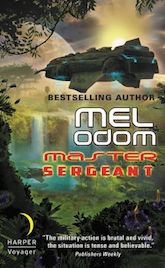 In Master Sergeant, Mel Odom introduces us to Makaum, otherwise known as the Green Hell. The planet is a maze of vicious vegetation defying every effort at containment. Like the burning sun and endless ice I’ve mentioned above, the jungle is inimitable, and it shapes the entire culture of the planet. It cannot be beaten back, but only be controlled for short periods of time, say for the purpose of clearing a landing pad. It’s a horrific and oppressive environment that leaves you wondering why anyone would want to live there.
In Master Sergeant, Mel Odom introduces us to Makaum, otherwise known as the Green Hell. The planet is a maze of vicious vegetation defying every effort at containment. Like the burning sun and endless ice I’ve mentioned above, the jungle is inimitable, and it shapes the entire culture of the planet. It cannot be beaten back, but only be controlled for short periods of time, say for the purpose of clearing a landing pad. It’s a horrific and oppressive environment that leaves you wondering why anyone would want to live there.
Turns out, the planet is rich in natural resources. Of course it is! This is science fiction at its best. Why put the most sought after mineral in the galaxy on a barren rock where anyone can get at it when you can bury it beneath a man-eating jungle on a planet also infested with drug runners and gangs? Seriously.
Master Sergeant is military science fiction, which I also love, and outside the superlative world building also tells a great story. Inclusion on this list, though, is down to the jungle. Imagine a world where you can’t walk a foot without bumping into herbicide and fire resistant poison ivy? Lots of it. Then make it carnivorous. Further imagine how an environment like that would shape your life? I want to write that book. I have notes for that book.
Interstellar
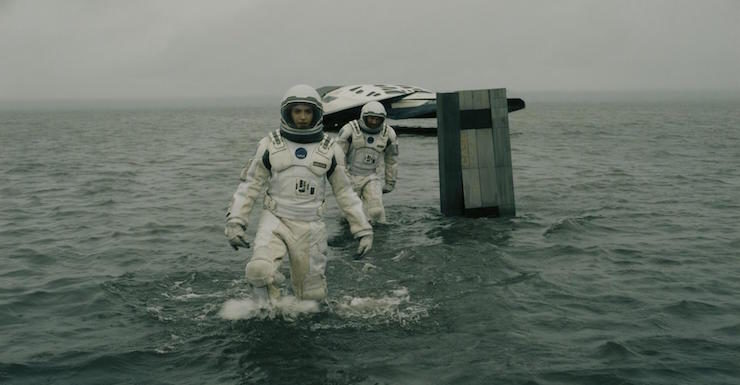
Lastly, let’s talk about Miller’s Planet from the movie Interstellar. Without giving too much away—it’s not a viable choice for colonization. The why of it is what makes it so fascinating, though. Not only is there a severe time dilation effect, meaning that time passes more slowly on the surface than it does outside orbit, but the place is literally one big ocean… and the black hole hovering over the horizon means there are some wicked tides. (The black hole also responsible for the time thing.)
There is land at the bottom of the sea, but both will disappear when the next wave hurtles past—at the height of Mount Everest. Disastrous and not particularly welcoming, but fascinating nonetheless. Ever since seeing the movie, I’ve pondered ways in which such a planet could be made habitable. I’ll let you know if I come up with something.
So, are you ready to visit Paradise Not? Inhospitable environments occur frequently in all forms of fiction—and in our own world—inspiring some of the greatest stories of people surviving against all odds, emerging perhaps damaged, always deeply affected, but also stronger and with greater resolve. These settings are often the ultimate test, and that’s why I love them so much.
Originally published August 2018.
 If aliens ever do land on Earth, Kelly Jensen will not be prepared, despite having read over a hundred stories of the apocalypse. Still, she will pack her precious books into a box and carry them with her as she strives to survive. It’s what bibliophiles do. Kelly is the author of a number of novels, novellas and short stories, including the Chaos Station series, co-written with Jenn Burke. Her novel To See the Sun is a queer SFF Romance featuring two men looking for a place to finally call home and finding it on an inhospitable planet on the edge of the galaxy. You can find her on Twitter @kmkjensen.
If aliens ever do land on Earth, Kelly Jensen will not be prepared, despite having read over a hundred stories of the apocalypse. Still, she will pack her precious books into a box and carry them with her as she strives to survive. It’s what bibliophiles do. Kelly is the author of a number of novels, novellas and short stories, including the Chaos Station series, co-written with Jenn Burke. Her novel To See the Sun is a queer SFF Romance featuring two men looking for a place to finally call home and finding it on an inhospitable planet on the edge of the galaxy. You can find her on Twitter @kmkjensen.










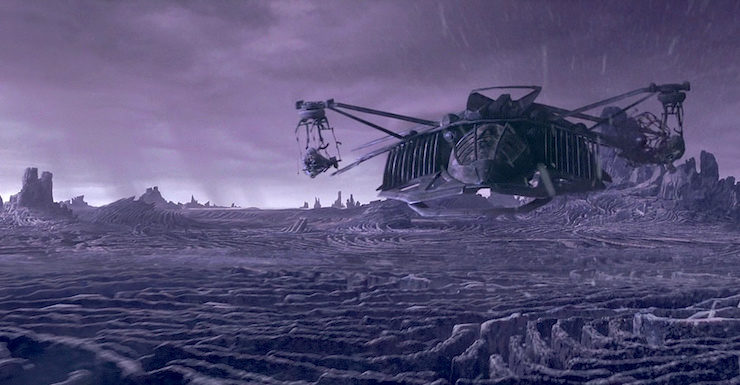
Alan Dean Foster did a bunch of inhospitable worlds. Mid-World, Tran-Ky-Ky, and Prism being the toughest on visitors.
H Beam Piper had Niflheim, with fluorine in the atmosphere.
Also via H. Beam Piper comes the Four-Day Planet, another memorable creation and the setting of his oligarchy-smashing best populist tale.
Harry Harrison’s _Deathworld_ springs to mind.
Hal Clement’s _Mission of Gravity_ (Mesklin) or Forward’s _Dragon’s Egg_ have increasingly hostile gravitational levels.
Niven’s _Known Space_ stories have a bunch of interesting “almost liveable” planets.
Can’t believe this article didn’t mention Hal Clement! Original and inhospitable worlds were his specialty. See: https://en.wikipedia.org/wiki/Hal_Clement#Planets
Oh, I forgot, Timothy Zahn’s Cobra series has Caelian, a planet with an agressively adaptive biosphere.
Oooh, how about Trisolaris from the Liu Cixin’s Three Body Problem?
Cordwainer Smith built a number of inhospitable planets: Shayol, Henriada (the “Storm Planet”), Paradise VII (first colony planet of the Norstrilians), Arachosia (“The Crime and Glory of Commander Suzdal”) to name a few.
Foster’s Midworld was the first one that jumped to my mind also. Of more recent vintage, the world from N.K. Jemisin’s Broken Earth trilogy.
*Sitting over in the 40k universe*
Oh hahaha yeah… yeah that’s cute I mean scary.
Um, Dune ????
Not a novel, but Ray Bradbury’s “Frost And Fire,” where the climate is so harsh that people live their lives in a week.
One of the grandmothers of all nasty worlds; Trenco from Doc Smith’s Lensmen series.
Helliconia by Brian Aldiss is a pretty unpleasant place with centuries long winters and summers.
The Empire of Man series by David Weber and John Ringo takes place mostly on Marduk, a planet with a very active and widespread rainforest biome, something like the early Eocene turned up to eleven. The people who evolved there know how to cope with it, but the humans find out quickly that even picking the wrong flower may kill you. Then the Mardukians who choose to travel with the humans on a very long trek discover that the same mountains that drive them into protective hibernation (which is not so much protective as lethally maladaptive that high up if nobody can stay awake to haul you along) are rather refreshing for humans.
The authors also spent some time thinking about what the biomes of Marduk do to local cultures. For example, hydraulic engineering is the supreme science among civilized Mardukians.
Paul@13: Helliconia was OK in Summer, IIRC – just the Winters were a bit nasty. (True in most such cases:, I think: C.F. Paul Park’s Paradise series, Michael Coney’s _Hello Summer, Goodbye_, or Robert Silverberg’s Winter’s End series.)
Our own planet is currently doing the same on a somewhat longer timescale, though it’s possible that we’ve found a way to dodge the final Winter of the current series…
[Edit: a longer timescale than Aldiss, Coney and Park: Silverberg’s series was based on the Nemesis hypothesis, in which a companion star of the Sun’s causes extreme meteoroidal impacts on the Earth every 26 million years.]
Stanislaw Lem wrote about some inhospitable planets, although the lack of hospitality has less to do with the physical environment than the failure of first contact with alien intelligence. The most famous is Solaris, the name of both the sentient ocean and its planet, and the name of Lem’s novel. “Solaris” was also translated to movie form at least twice (by Andrei Tarkowsky in 1971-2, and more recently by Stephen Soderburgh in 2002). Fiasco and Eden are two other failed first contact novels.
Poul Anderson’s The Snows of Ganymede begins, “Three dead men walked across the face of hell.”
Pluto, in Heinlein’s “Have Space Suit Will Travel,is also rather cold. But one of the planets in Niven’s “Crashlander” is the worst. Just being in orbit around it destroyed a General Products hull.
K.S. Robinson again: Aurora (Tau Ceti ?) from Aurora. Sensors say it’s kind of Earthlike, there’s oxygen, no signs of life. Sensors fail to say there are very high winds all the time, and everything is full of non-biological substances that will kill you.
Arthur Heinemann and D.C. Fontana: Eden from “The Way to Eden”, Star Trek. Has apple trees but is covered with acid and poison, is able to lure space hippies to go there for no reason. Also has the ability to make TV producers and directors lose all good judgment.
Dosadi from The Dosadi Experiment, Frank Herbert. Entirely terrible and poisonous except for a very small area where 89 million people live and are unable to leave. Someone wanted to see what would happen.
Harry Harrison’s Deathworld
Hydros in Robert Silverberg’s _The Face Of The Waters_. Exiled humans find temporary refuge on an ocean planet, but ultimately face rejection from both the intelligent inhabitants of Hydros, and the planet itself.
Marduk—- thePrince Roger series: Death planet, one each.
A Splendid Chaos by John Shirley.
It’s baffling that Dune is not even cited.
Three Body Problem seems like a winner
Pretty much anywhere in the solar system is far more inhospitable than any of the fictional ones in the list. The ice sheet in “Left Hand of Darkness”? Please. You can breathe the air, you can melt ice for water. Wrap up warm and bring a sandwich and you’ll be fine. Humans can survive that kind of environment indefinitely with nothing more advanced than Stone Age technology. Present day humans go to that kind of environment for a relaxing holiday.
Compare that to Mars, or the Moon, or Europa, or god help us Venus.
I think Hothouse (Brian Aldiss) might trump Makaum, seeing as in that case it’s future Earth itself.
Seems to me the masters have been forgotten by these newer writers. Avram Davidson, anyone?
Dune, of course, although the Baron’s home world seems worse.
Not a planet but an inhabited environment, Niven’s Integral Trees in The Smoke Ring strikes me a fairly horrible place to live.
And the Tines’ world, from Vernor Vinge’s Zones of Thought universe. Heck, not just the planet, but the entire universe seems pretty bad!
Oh, and, while I can’t remember offhand the name, the planet from the movie Enemy Mine. That place sucked!
Thanks for mentioning Dune, Dean B.
Kim Stanley Robinson’s Mercury city on rails is inspiring – so imagine staying just ahead of Interstellar’s miles-high wave while enjoying the hedonistic urban lifestyle of a city that surfs.
@30: What’s wrong with the Tines’s world (except too many dogs, not enough cats)?
As for the universe, it’s supposed to be ours or similar, I think….
I thought about Dune, but in the end I don’t think it qualifies as that inhospitable compared to many of these other “death worlds”. The Fremen have been living wild long enough to establish a niche culture, the colonial/Imperial cities are well established and supported. If Dune is inhospitable then Egypt is inhospitable. Uncomfortable, perhaps, and certainly at the edge of human habitation limits, but not completely inhospitable. Most of the planets listed are 95%+ “kill you without extreme exceptions” and while Dune has some pretty deadly spots, it seems like humans manage to eke out existence in large swaths of it…
Avida, in Colin Kapp’s The Survival Game; its last hundred occupants were evacuated to become the toughest fighters in the forces of one of the star kings, who made it the site of his “game”
Another reason The Left Hand of Darkness doesn’t belong on this list: this is a list of inhospitable planets. Most of Gethen is perfectly OK.
Niven’s Cannonball Express (from the short story Flatlander) wins the prize for most inhospitable, surely.
Gethen is a bit chilly, but it has luxuries like breathable air and relatable, hospitable, albeit fickle, people. Genly Ai got caught up in local politics.
These planets are habitable (although how is frequently hand-waved away). Most of this planet will kill a human without technological assistance; about the 2/3 of the Earth is covered by water to an average depth of a few hundred meters. These planets are certainly less comfy than, say, Ischia, but I think I’d rather vacation on themthan, say, Venus or Mars.
Stanley Weinbaum’s superjungle version of Venus was pretty inhospitable.
http://www.spacewesterns.com/articles/14/
Pern is one of those planets that looks like it’s the opposite, and then oops! Massive outpourings of flesh devouring thread fall from the sky every so often. It’s a bait and switch ;) It’s not barren and inhospitable in the extreme sense mentioned in this article, but it does present a challenge.
Regarding Dune, Arrakis may not be strictly inhospitable, but Salusa Secundus may be as it’s specifically intended to train their death troopers.
The point made about Arrakis is it’s worse than Salusa Secundus, and the Fremen are correspondingly tougher than the Sardaukar.
You’re rigt, I completely forgot that!